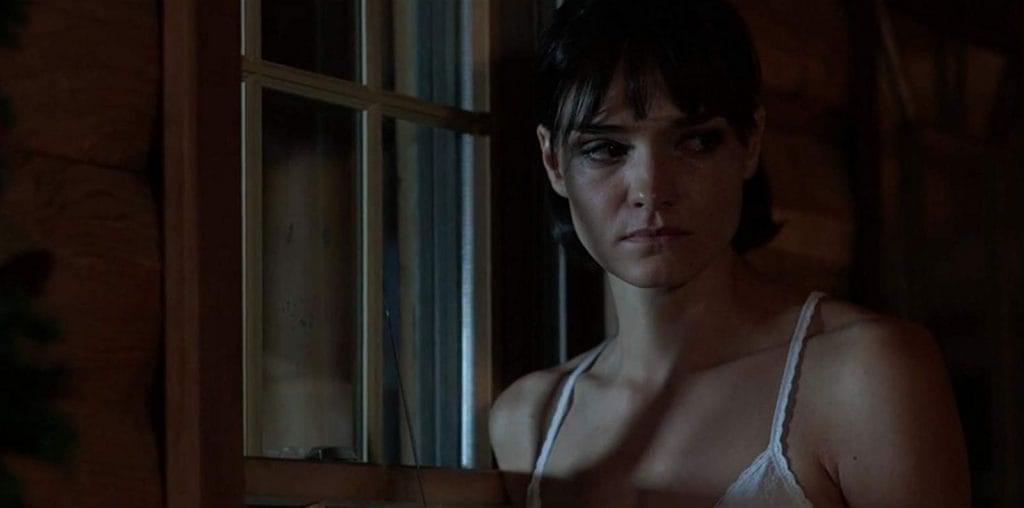
“My name is Aisha Osagie” a young woman stutters, deliberately composed. “I have to go home for an emergency funeral. I- I need help with that.”
“Okay,” the voice on the other end is pleasantly neutral. “Could I get your registration number, please?”
Moraya Osagie was alive days ago– terrified and in hiding but full of faith. Aisha is about to hear what she already knows. Attending her mother’s funeral would require voluntary return to Nigeria and the withdrawal of Aisha’s appeal for asylum in Ireland. Her steady downward gaze–her control–begins to fracture.
A tentative warning for viewers: Aisha demands not only attention but patience. This film was not created to instruct the masses on a global humanitarian crisis or to reproduce the struggle of the marginalized for catharsis. It will not satisfy the expectation that such stories will be raw, unambiguous, and wrap up cleanly by the hour-forty mark, nor does it necessarily do ‘art film’. What makes Aisha interesting is the balance struck between these elements, how that affords dignity to its characters, and how that dignity is, by extension, afforded to the lived experience such characters embody.
The film begins– to the sound of rhythmic chanting and stomping– with an intertitle. We are told that the film, written and directed by Frank Berry, was researched with “current and former international protection applicants” to Ireland and is “inspired by real life experiences”. Fade in as light streams onto the joyful faces of a crowd, running through a step routine. A young woman faces away from us, her green headscarf centering the frame. Her name means ‘life’ and is shared by a large population of Muslim and Arabic women (‘Aisha’ was also the wife of the Prophet Muhammed). Aisha, our protagonist, is introduced as a representational figure; she is the vehicle through which “real-life experiences” will be depicted.
Control and focus thematically and technically underscore the visual language of Aisha. Violence occurs out of frame. When a family is arrested for deportation, when Moraya is killed, and when Aisha herself is harmed, that information is kept from viewers. Whereas Aisha is often framed by her environment– through doorways, windows, and mirrors– others intrude upon the space. Police officers and social workers (men, generally) fail to enter the frame completely, becoming disembodied, headless uniforms. Environments are richly populated by extras upon which the camera might focus– but never settle– until Aisha comes into view. In this way, the construction of an ‘outer’ world reinforces our perception of Aisha’s ‘inner’ world.
A second warning: Characters in this film do stand, sit, and kneel in the dark, eyes unfocused in the middle distance, and they do it repeatedly. While a potential turn-off for some viewers, it is a mistake to interpret these scenes as static. Performed by Letitia Wright, Aisha’s frequent ‘gazing’ shifts from unaffected to caged, to fond, to angry, to fatigued, to lost, and always processing, always composed, always struggling for control.
Aisha’s interior world conflicts with her identity as an immigrant, an asylum seeker– a case number. Presenting herself as a “good listener,” the women Aisha services at the salon are more interested in her migrant status, asking where she’s from– you know, originally. They want access to her story: It’s all part of the service. Prepping to appeal, Aisha’s solicitor urges her to ‘share more details’, to put the interviewer– another arm of a hostile apparatus– “in the room” where Aisha was raped, her brother and father murdered. Socially and legally, Aisha’s survival depends on ‘selling’ herself as a victim.
The ways in which this story is political are intertwined with the ways in which it is romantic. At the first accommodation center– Aisha meets a young security guard named Conor (Josh O’Connor) and– in stolen glances and nights in the kitchen, a relationship develops– until Aisha is forcibly relocated. Thrown into another survival situation, Aisha wants control. She wants to reveal herself to Conor. She tries to warn him off. Wright and O’Connor’s performance is subtle and nuanced, building a chemistry that communicates the most in silence. Through Conor, we see Aisha’s emotional walls in a new light– not as restricting access to her past but to herself. When Conor confesses his feelings, Aisha responds, “I can’t be with anybody. My life is nowhere it needs to be. I’m not even sure I have a future.”
As the film wraps up, the question of Aisha’s future still hangs in the balance. It is her romantic story that is resolved, not her appeal status. Having been invited to understand Aisha as ‘inspired by real events’, we come to understand Aisha as a woman– her history, her psychology, and her perspective– that is, her life, ‘not a story.’


